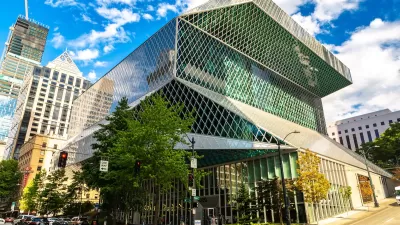The public spaces where people can spend time among strangers without buying something are crucial to healthy cities—and are quickly disappearing.

Writing in Strong Towns, Tiffany Owens Reed vividly describes the pleasures of ‘third spaces,’ those truly public spaces that provide a safe, vibrant place to just exist without having to purchase anything or be engaged in any particular activity.
These spaces attract all kinds of people and facilitate all kinds of activities. They’re organic, uncoordinated, and leisurely. They function like an extension of our own living rooms or backyards. Their value comes from providing a space where strangers can happily be alongside other strangers doing something they enjoy.
Owens Reed doesn’t have an explanation for the phenomenon, but asserts that “there’s something magnetic about spaces where strangers can be alone together, and in our increasingly fragmented and polarized society, this is valuable.” To that end, cities should protect these increasingly rare spaces where all kinds of people can mingle.
Owens Reed recommends three keys to creating good public spaces: keeping them closed to cars; making them “clearly defined and slightly enclosed” to create a sense of safety; and placing them near businesses without making them transaction-focused. “When public parks, squares, and plazas are situated close to practical businesses, it creates a beneficial cycle for them both: public spaces provide places to be while businesses provide options of things to do, both increasing foot traffic, overall vitality, and safety.”
The piece concludes with a provocative question: “What would our cities look like if we designed for all of life, not just a few activities that we can count on for tax revenue?”
FULL STORY: No Purchase Necessary

Rethinking Redlining
For decades we have blamed 100-year-old maps for the patterns of spatial racial inequity that persist in American cities today. An esteemed researcher says: we’ve got it all wrong.

Planetizen Federal Action Tracker
A weekly monitor of how Trump’s orders and actions are impacting planners and planning in America.

California High-Speed Rail's Plan to Right Itself
The railroad's new CEO thinks he can get the project back on track. The stars will need to align this summer.

San Francisco Muni Raises Fares a Second Time
A 10–cent fare hike for adults is part of the agency’s plan to chip away at a growing budget deficit.

Electric Grid Capacity Could Hamstring EV Growth
Industry leaders say the U.S. electric grid is unprepared for the increased demand for power created by electric cars, data centers, and electric homes.

Texas Bill Supports Adaptive Reuse in Commercial Areas
Senate Bill 840, which was preliminarily approved by the state House, would allow residential construction in areas previously zoned for offices and commercial uses.
Urban Design for Planners 1: Software Tools
This six-course series explores essential urban design concepts using open source software and equips planners with the tools they need to participate fully in the urban design process.
Planning for Universal Design
Learn the tools for implementing Universal Design in planning regulations.
City of Camden Redevelopment Agency
City of Astoria
Transportation Research & Education Center (TREC) at Portland State University
Regional Transportation Commission of Southern Nevada
Toledo-Lucas County Plan Commissions





























